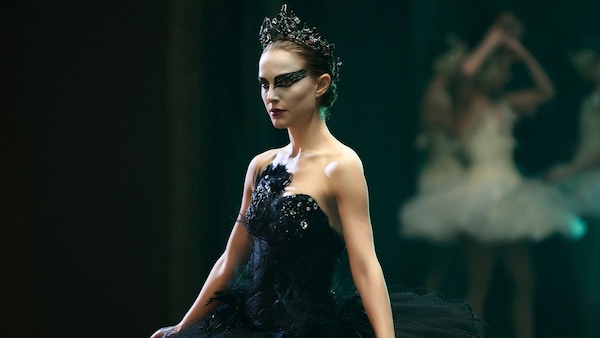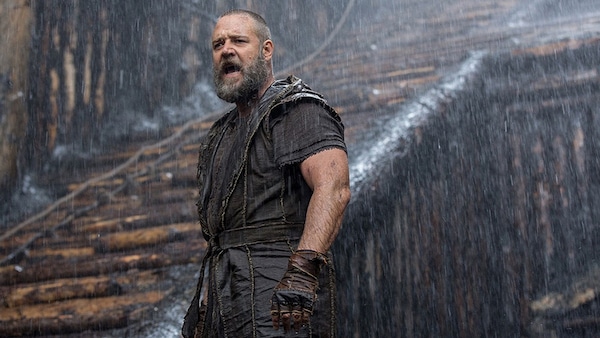Christ & Conflict: The Dark Gospels Of Darren Aronofsky
Darren Aronofsky’s filmography could well be considered a career-long reckoning with the unknowable (death, God) and the unattainable (immortality, perfection), writes Prahlad Srihari.

Last Updated: 01.22 PM, Feb 26, 2023
THE TITLE of Darren Aronofsky’s new film The Whale is a triple entendre. First, it is a sly nod towards its housebound 600-pound protagonist Charlie (Brendan Fraser) whose depression and self-loathing have pushed him to eat himself into an early grave. Second, it is a reference to a student essay on Moby Dick whose passages Charlie reads aloud to calm himself. Third, it alludes to Jonah’s fate in the Old Testament: grief is swallowing Charlie whole and the apartment he confines himself to starts to feel like the belly of a beast.
Outside the window, rains lash down relentlessly, divining the arrival of an allegorical flood like something out of Genesis. The films of Aronofsky have always been awash in a sea of Judeo-Christian imagery and allegory. In a career spanning 25 years, the American writer-director has built a body of work around self-destructive protagonists who find themselves trapped in a conflict between their delusions and reality, their faith and reason. Faith, be it in God or self, is forever being questioned and challenged.
Mathematicians, junkies, wrestlers, ballerinas and shut-ins are driven to the edge of sanity by their singular obsessions (perfection, drugs, omniscience, immortality). Aronofsky treats his characters as martyrs grasping for redemption, attempting to defy their fate and the will of God itself. Redemption doesn’t come easy. Some get closer than others. In the so-close-yet-so-far futility of it all, we come to feel in concert a deep sense of their despair.

The visceral cinema of Aronofsky leverages the aesthetics of embodiment. The body becomes an arena for inner conflicts to be fought out. In The Whale, the struggle to reconcile faith and sexuality forces a man to starve himself to death, the trauma of which forces his boyfriend’s body to shut down in an adverse opposite reaction. Mickey Rourke’s eponymous has-been in The Wrestler doesn’t let his sell-by date or a heart attack stop him from putting his body through the wringer for a potential comeback. Natalie Portman’s ballerina in Black Swan endures mangled toes, a bruised back and a stab wound, sacrificing her body for the intangible ideal of perfection. If the professional heights that the wrestler and the ballerina seek can only ever be transitory, what Hugh Jackman’s scientist in The Fountain seeks is to transcend the human condition itself, as he travels across space and time to find a cure for his terminally ill soulmate. The addicts in Requiem for a Dream seek escape, fleeting though it may be, from their everyday reality through drug use. Go all the way back to Aronofsky’s debut Pi: a mathematician’s quest to predict the stock market turns into an investigation into the mind/body schism and all that is unknowable.
Aronofsky’s filmography could well be considered a career-long reckoning with the unknowable (death, God) and the unattainable (immortality, perfection). Each film is as much a ritualised act of doubt as an act of faith, refracting his worldview as if through a stained-glass window. The problem is: if you put them together on a wall, they might not offer too much clarity of perspective. From one film to the next, he tends to wrongfoot even his apologists. It's why his barefaced allegories are often mistaken for sophomore pretentiousness. Such peeves notwithstanding, his films are never not bracing and always open themselves to intelligent readings.

In The Whale, the dangerously obese Charlie shuts himself off from the world after his boyfriend Alan dies by suicide. He is an English professor but teaches remotely via Zoom with the camera off. He leaves cash in the mailbox so the pizza delivery guy can’t see him. He is so ashamed of his appearance he stays out of sight from those quick to judge. But suffering congenital heart failure won’t stop him from inhaling pepperoni pizzas loaded with mayonnaise, meatball subs with extra cheese, and buckets of KFC. He refuses treatment even. When we first meet him, he is masturbating to porn so furiously his heart seizes up. He is living out what might be the final week of his life, time he wishes to use to connect with his estranged daughter Ellie (Sadie Sink) who has no kind words to spare. Abuse, pain, scorn, shame, guilt — hurl what you want at Charlie — he will absorb them all like a sponge.
When the Bible thumper Thomas (Ty Simpkins) manipulates Charlie with the promise of redemption, it serves as a reminder of the damaging effects of a religion which says homosexuality is a sin and teaches people to hate their bodies. The film’s screenwriter Samuel D Hunter, adapting his own play, draws from his own experiences as a gay man who attended a fundamentalist Christian school in the American Midwest, battled depression, and coped with it by overeating.

Among all of Aronofsky’s characters, Charlie most reminds us of Rourke’s Randy ‘The Ram’ Robinson in The Wrestler. Both struggle to reconnect with their daughters, live in denial, and look for redemption in the wrong places. While the allegories Aronofsky employs are pointed, there is no denying the imagery can be overwrought. Aronofsky sure sells us hard on the idea of Randy as Christ figure. Marisa Tomei’s character spells it out even, citing a verse from the Book of Isaiah: “He was pierced for our transgressions. He was crushed for our iniquities. The punishment that brought us peace was upon Him, and by His wounds we were healed.” Gracing Randy’s back, underneath the Jesus hair, is a tattoo of Jesus. One brutal showdown ends with a deep cut on his chest punctured and bleeding from barbed wire. The final showdown ends with him pulling out his signature finishing move, the “Ram Jam”, where he dives from the top rope, arms stretched out, in a crucifixion pose, as if to suggest he must suffer for his fans. One person’s sacrifice is another person’s salvation, Aronofsky seems to say. The Whale similarly casts Charlie as a Christ figure. But its mistake lies in putting the onus of accountability and absolution on Charlie rather than those meting out cruelty and abuse onto him.
Watching Aronofsky’s actors descend into the depths of agony makes for a punishing experience for the viewer as well. Fraser brings an emotional restlessness to a mostly immobile character who is hiding his body but baring his soul. Just as The Wrestler helped Rourke make a big-screen comeback that culminated in an Oscar nomination, The Whale has done likewise for Fraser — a veritable second coming which may just earn him Oscar glory.

Depending on the redemptive/reflective angle of the film, Charlie can be seen as Jonah and the whale. He is a man consumed by his fears. At the same time, he is a being sent as a reminder of how we can be our own worst enemy. Aronofsky repurposed Noah with a similar function in his take on the story from the Book of Genesis. The modern threat of climate change looms large over the film. Humans, in their insatiable desires, have cut down surplus trees, plundered natural resources and destroyed ecosystems entire — and it is hard not to see why God would want a do over. The divine decree communicated to Noah is also a wake-up call about an apocalypse that may wipe all life on Earth and our power to still stop it.
In the follow-up Mother!, Aronofsky again grappled with how mankind’s selfishness has led to the endless destruction of the environment. Where Noah recounted the story of creation, destruction and recreation from the point of view of a masculinised God, mother! did the same from the point of view of a feminized Earth. Some call her Gaia. Some call her Bhudevi. Some call her Mother Earth. Embodied by Jennifer Lawrence, she is a woman ready to rip her heart out of her chest again and again to bring life into the world. Javier Bardem plays the Patriarchal God who feeds on her goodness, spirit and very being to keep appeasing mankind till its eventual destruction. First to be invited to their Eden are Adam (Ed Harris) and Eve (Michelle Pfeiffer). Cain (Domhnall Gleeson) and Abel (Brian Gleeson) follow. Mankind’s opportunism, jealousy and immodesty causes the invitation to inevitably become an invasion. The film is loaded with Biblical symbols, from un-braced sink portending the Flood to a new-born representing Jesus. In this expedited retelling, Jesus is killed by humans who drink his blood and consume his flesh. It sure is a lot bloodier than the Holy Communion churchgoers may be used to. But it plays into the idea of how the blood of Christ is purported to have the power to cleanse us from sin and renew life.

Aronofsky is an atheist both at odds and in awe of what faith offers — as opposed to science. When the tree of life becomes a cure for cancer in The Fountain, faith accomplishes what science can’t. Faith vs science is spotlighted in the two creation narratives presented in Noah. The first, which opens the film, is the literal version found in the Book of Genesis with Adam and Eve eating the forbidden fruit in the Garden of Eden. The second, which appears in a montage 80-odd minutes into the runtime, attempts to reconcile the scientific perspective with an interpretation of the Bible in more figurative terms. When God says, “Let there be light,” we see the Big Bang. God creating land animals and humans on the sixth day is coupled with a segment showing human evolution from single-celled organisms in the sea.
It’s not just Judeo-Christian ideas that undergird Aronofsky’s films, ideas from Hinduism and Buddhism can be found in them as well. The Western and Eastern influences aren’t at odds with each other, but work in concert. For what Aronofsky seeks to engage with are the larger questions about the human condition common to them all. The cycle of rebirth is not only a key theme in The Fountain, it is coded into its very structure. Jackman’s character reincarnates thrice over a period of thousand years in his search for eternal life. The three narratives existing in three time periods are in essence a free-form expression of reincarnation. The theme recurs in mother!, where the world is created, tested, challenged, destroyed and recreated in an endless cycle. The cyclical notion of time informs its structure too. The structure of Pi assumes a pattern that befits a thriller centred on a number holding the key to unlocking the secrets of the universe. Mathematician Max (Sean Gullette) is determined to find a formula that explains the behaviour of the stock market. Paranoia sets in when his work attracts the attention of a shady Wall Street firm and a Hasidic sect that is convinced a 216-digit number contains the true name of God.

Since his debut, Aronofsky’s reputation as one of independent cinema’s saviours appears to have taken a beating with each film. In the attempt to put a label on his authorship, critics have landed all over the map, branding him as everything from “miserabilist” to “arthouse poseur,” from “deeply religious” to “sacrilegious.” But even when he misses (as he does with The Whale), the misses still make for revealing discourse (outside of Twitter of course). One doesn’t have to understand the Biblical context to register the deeper meanings to his work. For it is the kind of work that jolts us out of passive spectatorship and plunges us into active reflexivity, forcing us to consider the consequences of unchecked greed, bigotry, obsession — and climate change.
